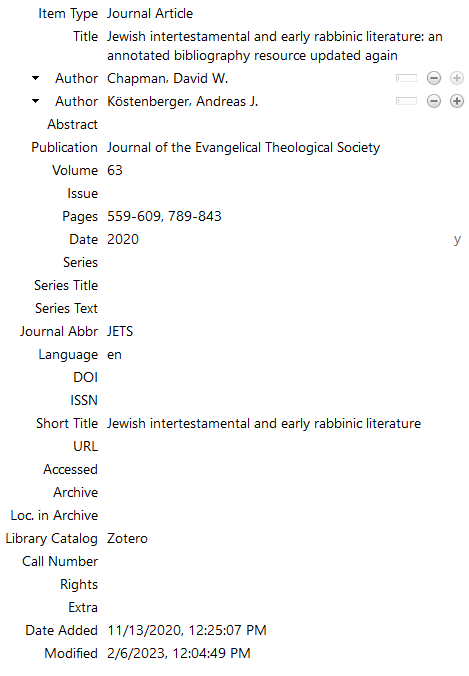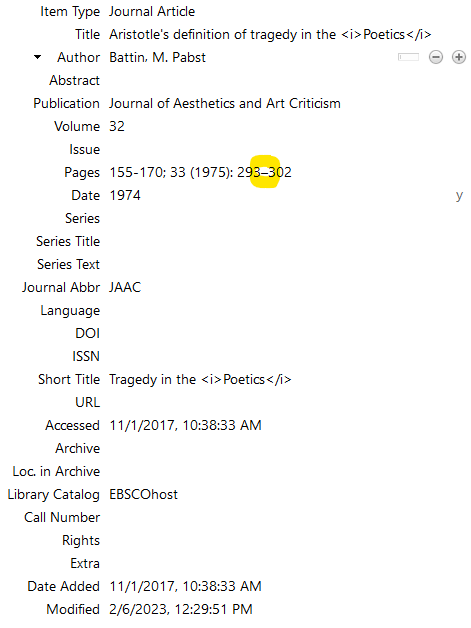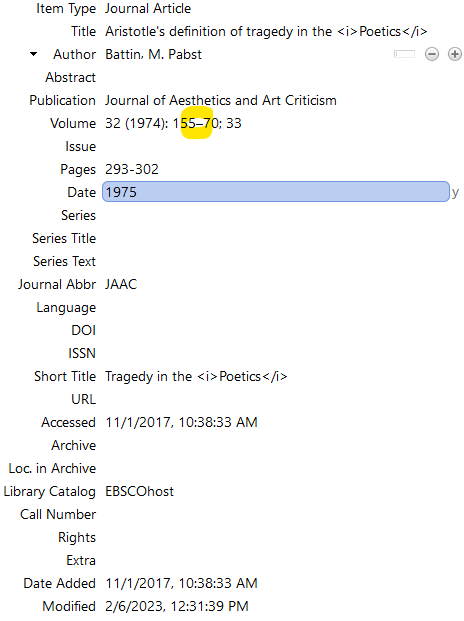Sometimes, journal articles are too long for their usual format.1 So, they get serialized, or broken up across multiple journal issues.
The guidance that the SBL Handbook of Style provides for how to cite these articles contains a couple ambiguities. But assuming for the moment, however, that proper resolutions for these ambiguities are discernible, how might you accommodate such a citation with Zotero?
Serialized Articles within the Same Volume

If all of the parts of a serialized article appear in the same volume, as with the Wildberger example, all you really need to do is to include all of the different parts’ page ranges in Zotero’s “Pages” field.
In this way, you could get citation and bibliography information like
David W. Chapman and Andreas J. Köstenberger, “Jewish Intertestamental and Early Rabbinic Literature: An Annotated Bibliography Resource Updated Again,” JETS 63 (2020): 559–609, 789–843.
Chapman, David W., and Andreas J. Köstenberger. “Jewish Intertestamental and Early Rabbinic Literature: An Annotated Bibliography Resource Updated Again.” JETS 63 (2020): 559–609, 789–843.
Serialized Articles across Multiple Volumes
For articles serialized across multiple volumes like the Wellhausen example, you’ll want to enter
- the earliest volume’s year in Zotero’s “Date” field and page range in the “Pages” field followed by the volume number, year, and page ranges for the subsequent parts of the article or
- the latest volume’s year in Zotero’s “Date” field and page range in the “Pages” field because you’ve included all of the earlier volume information in the “Volume” field.
Zotero doesn’t have a “serialized journal article” item type to allow you to specify the individual volumes and pages for those volumes where an article was serialized. But either of these methods will allow you to shoehorn the information you need into the appropriate Zotero record. Zotero will then be able to produce citations like those shown below.
M. Pabst Battin, “Aristotle’s Definition of Tragedy in the Poetics,” JAAC 32 (1974): 155–70; 33 (1975): 293–302.
Battin, M. Pabst. “Aristotle’s Definition of Tragedy in the Poetics.” JAAC 32 (1974): 155–70; 33 (1975): 293–302.
Just be aware that a side-effect of this shoehorning is that Zotero won’t be able to automatically
- transform hyphens to en dashes in some of your page ranges or
- abbreviate the last page number in the range according to the rules that SBL style uses.
So, you’ll need to ensure you enter an en dash (rather than a hyphen) and abbreviate the page range as appropriate for yourself when entering the item’s Zotero record.
Now, as to the addressing the special difficulties with this type of citation, you might be able to avoid both of them if you
- simply make your first citation a citation of the serialized article as a whole and
- don’t subsequently need to specifically cite any pages that occur in more than one of the serialized articles.
Citing Part of a Serialized Article Only on the First Reference
But if you need to cite something less than the whole serialized article the first time you cite that source, you can create a second Zotero record just for the sub-part of the article you need to cite.
So, you might have two journal article records with the title “Die Composition des Hexateuchs.” One would include the full serialized information; the other would include only the information for the part you need to cite individually.
In your footnotes, you would use only the one with the part of the article. That way, Zotero could produce short or full notes properly.
When it comes time to produce a bibliography, you’d then use the Add/Edit Bibliography tool to remove this record and insert instead the record with the full serialized article information.
Disambiguating Page References in Short Citations
You can easily disambiguate page page references to particular articles in a series from the citation dialog. In the locator field there, you’ll just enter the volume number, a colon, and the page range you want to cite (e.g., “21:407–50” in the Wellhausen example).
When you do so, just be aware that having the volume number in the locator field won’t allow Zotero to transform hyphens into en dashes or abbreviate the last number of a page range as it usually does. So, you’ll need to enter these components as such (i.e., the text “–50” in the Wellhausen example).
Conclusion
SBL style involves several specific details that can prove challenging to accommodate consistently. Nevertheless, Zotero is able to handle even cases like serialized journal articles.
It can take some massaging and trial-and-error to see exactly how best to incorporate the data you need to get the citation format you’re looking for. But once you’ve got that saved in Zotero, it isn’t something you’ll need to bother with further.
Header image provided by Zotero via Twitter. ↩



Leave a Reply